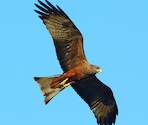
Most scientists are in agreement that birds evolved from egg-laying, predatory dinosaurs that existed during the Triassic some 225 million years ago (mya), whereas the earliest known bird is the crow-sized Archaeopteryx, which dates back to the Jurassic (150 mya).
From a genetic perspective, the egg also wins - mutations happen within the egg, not in living animals, and the organism inside any egg will always carry the same DNA as that of the creature that will hatch from that egg. By the way, the ancestor of today's Common Chicken (Gallus domesticus) is probably the Red Jungle Fowl (Gallus gallus) that inhabited the dense bush of south-east Asia a mere 6 000 years ago.
The group of small reptilian-like, bipedal dinosaurs that eventually gave rise to birds are known as the Pseudosuchia - their remains have been found in the Karoo and in Europe. Between 200 mya and 150 mya the elongated scales of these flying reptiles developed into feathers, while their bodies took on features similar to those of anatomically modern birds. The fossil remains of Archaeopteryx, first found in a German swamp in the 1860s, clearly show feathered wings and a reptilian jaw.
Sea birds are among the oldest birds - some 23 gull-like species have been identified from the Cretaceous (135 mya). Among the birds from this era are the fish bird Ichthyornis, and Hesperornis with its beak full of teeth.
By the Eocene (70 mya), modern bird anatomy had evolved and diversified into two major divisions - the Carinates, which were capable of flight, and the Ratites, which were not. The Carinates included pelicans, herons, cranes and gulls while the Ratites included the Giant Elephant Bird (Aepyornis maximus) which stood almost three metres high, as well as moas, rheas and the ancestor of the ostrich.
Of the 770 or so land bird species recorded in southern Africa, 112 are endemic to what is zoogeographically defined as the southernmost range of the Ethiopian Region. The endemic species are mostly birds of the highveld, escarpment, fynbos and the arid south-western parts of South Africa. There are no regular Kruger species that are endemic.
The Hamerkop and Secretarybird families are not found elsewhere in the world so one can assume they evolved in Africa. The 13 other families of birds believed to have originated in Africa include the bustards and the korhaans, the coursers and pratincoles, the sandgrouse, bee-eaters, African Hoopoe, hornbills, honeyguides, larks, wagtails, pipits and longclaws, bulbuls, sunbirds, weavers and starlings. Sixty percent of the bird families found in southern Africa are believed to have evolved in Asia or Europe.
Geological period | Age of Base | Duration Mya* | Evolutionary aspects | Changes in the African landscape |
Recent | - | - | Evolution of modern humans, modern bird migration patterns develop | Increased aridification |
Pleistocene | 3 | 3 | Humans evolve from australopithecines, savanna mammal species become dominant in Africa; ostriches widespread through Africa, southern Europe, India and China | Successive ice ages in Europe; Africa arid with savanna grassland increasing in range |
Pliocene | 12
| 9 | Earliest evidence of ostrich (from India); split between ancestral apes and ancestors of australopithecines | Savanna grassland replaces forest canopy as African climate changes |
Miocene | 25 | 13 | Primate evolution at its height | Widespread tropical conditions in Africa reach their peak |
Oligocene | 40 | 15 | Earliest evidence of cuckoos, parrots, swifts, trogons, shrikes, wagtails and rollers | African landmass blanketed with forests |
Eocene and Palaeocene | 70 | 30 | Archaic mammals, beginning of modern birds, first penguins, earliest owl fossil, earliest evidence of woodpeckers, diving birds and pelicans | Africa stabilises after geological upheavals of continental drift; climate allows for widespread afforestation across the continent |
Cretaceous | 135 | 65 | Flowering plants, birds become specialised, last toothed birds, last dinosaurs | Madagascar separated from African mainland; seismic tilt as eastern seaboard of Africa tips into Indian Ocean, formation of escarpment |
Jurassic | 180 | 45 | Dinosaurs rule the earth, flying reptiles are common, toothed birds make their appearance, first fossil of reptile-like bird Archaeopteryx | Seas invade continents, Gondwanaland begins splitting up; intense volcanic activity in Kruger sees the basalt and rhyolite laid down; formation of Lebombo mountains |
Triassic | 225 | 45 | Dinosaurs and first mammals evolve, ancestor of birds believed to be a small bipedal reptile | Africa part of super-continent Gondwanaland (includes Australia, South America, India, Antarctic, Madagascar); glaciers begin retreating as climatic conditions shift |
Permian | 270 | 45 | Many land vertebrates; evidence of mammal-like reptiles in the Karoo (believed to be ancestral to dinosaurs) | Glacial conditions develop over southern Africa |
Carboniferous | 380 | 50 | Coal plants and amphibians | Extensive swamps with coal formation, formation of Ecca shales in Kruger |
Devonian | 400 | 50 | Land plants and many fishes | Extensive warm shallow seas |
Silurian | 440 | 40 | Earliest land plants; giant sea scorpions | Shallow seas and hot, dry climate |
Ordovician | 500 | 60 | Cephalopods and graptolites | |
Cambrian | 600 | 100 | Trilobites and brachiopods |
